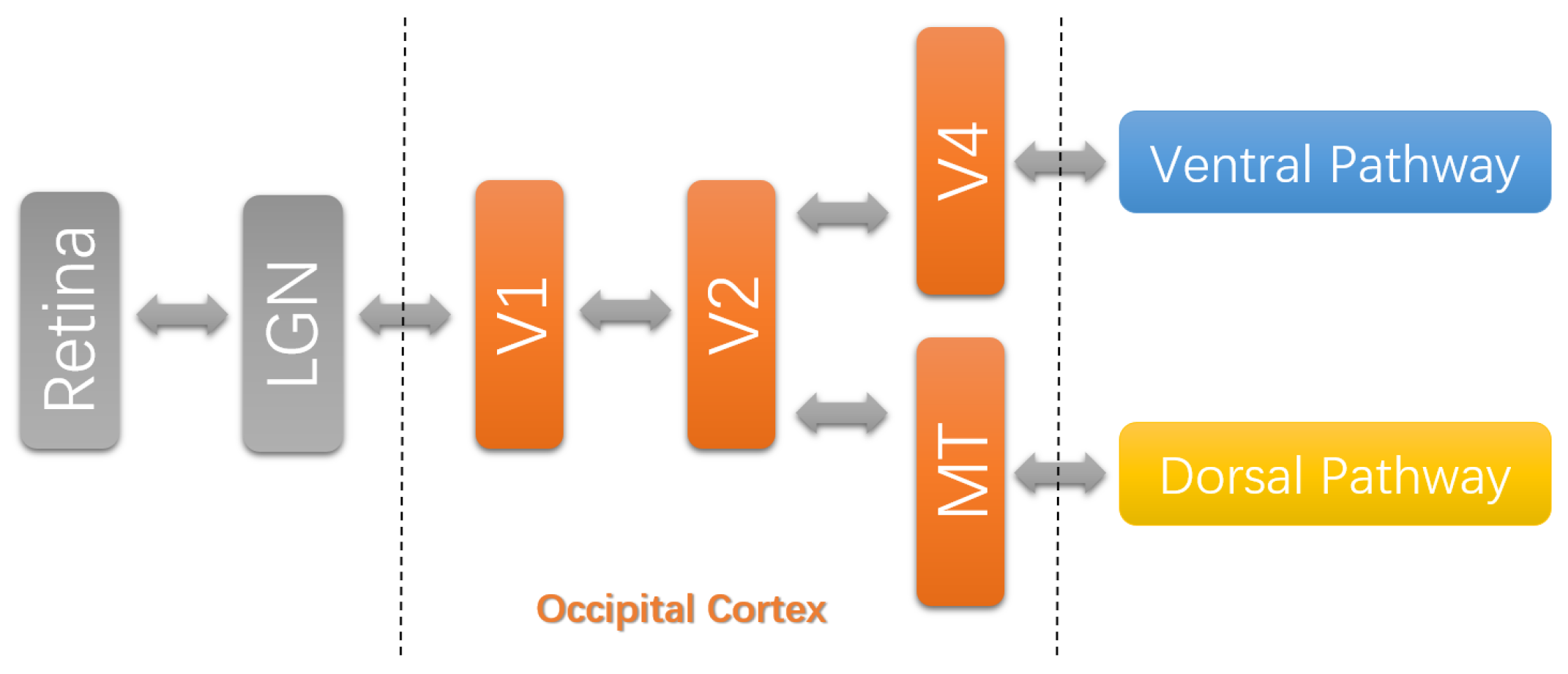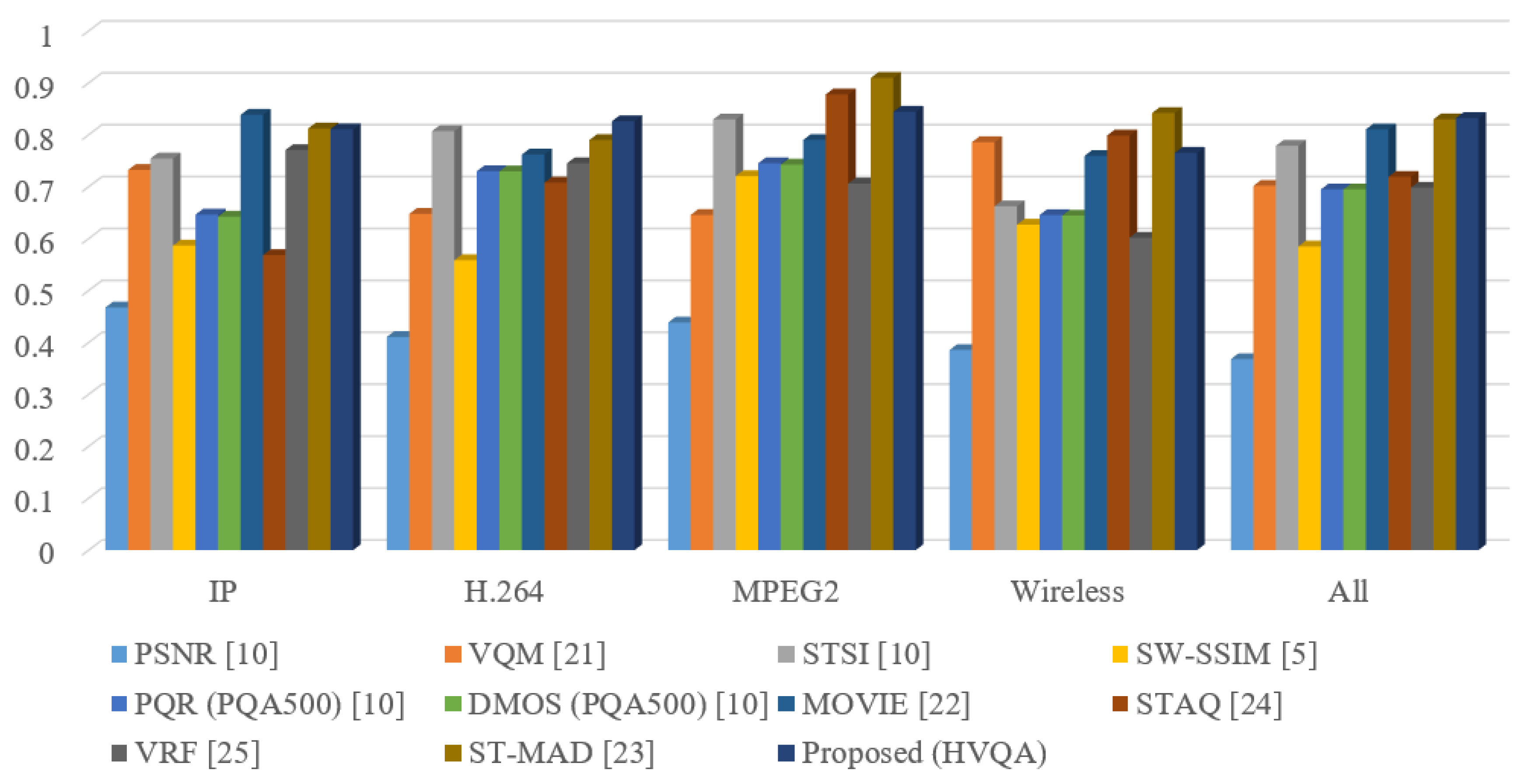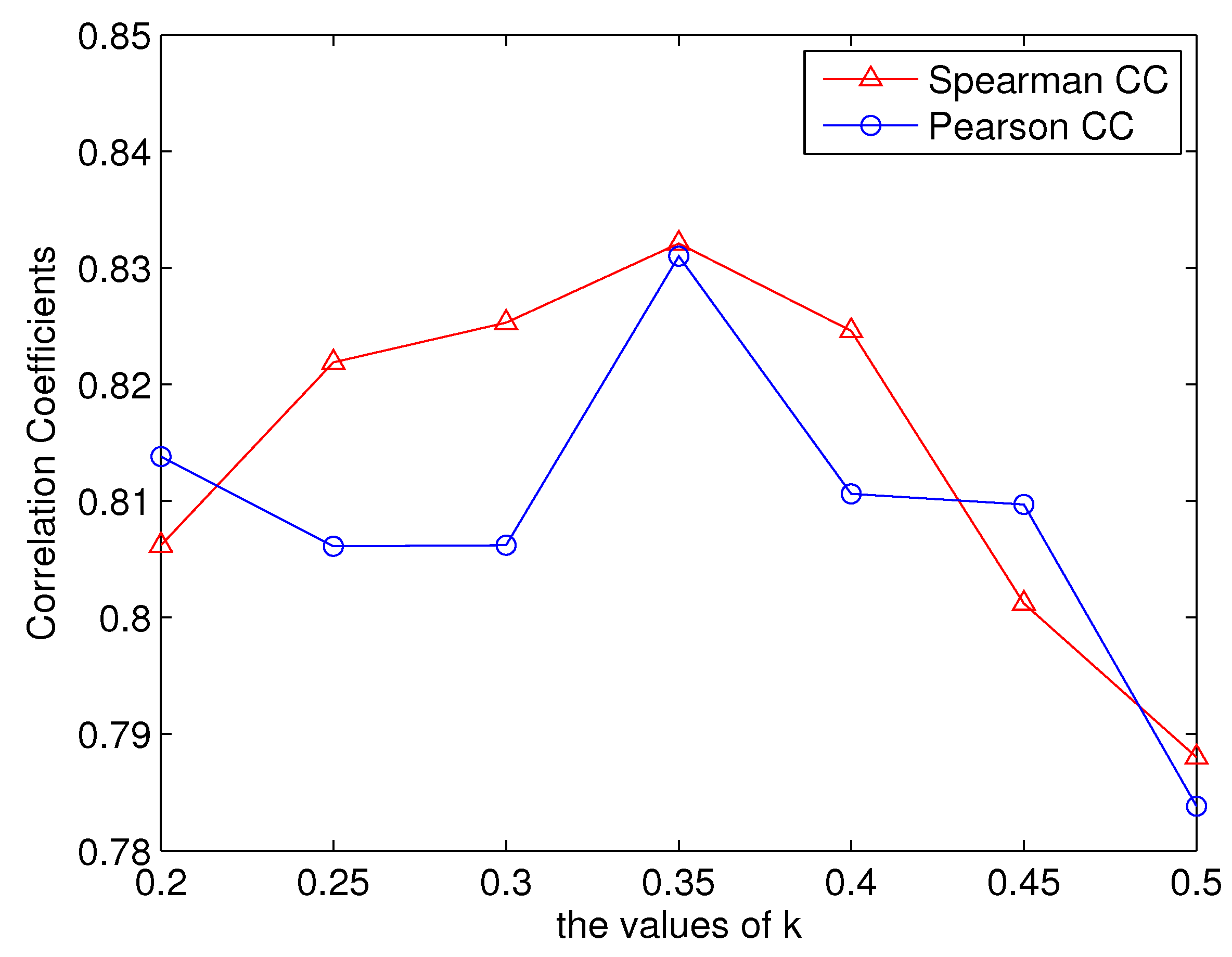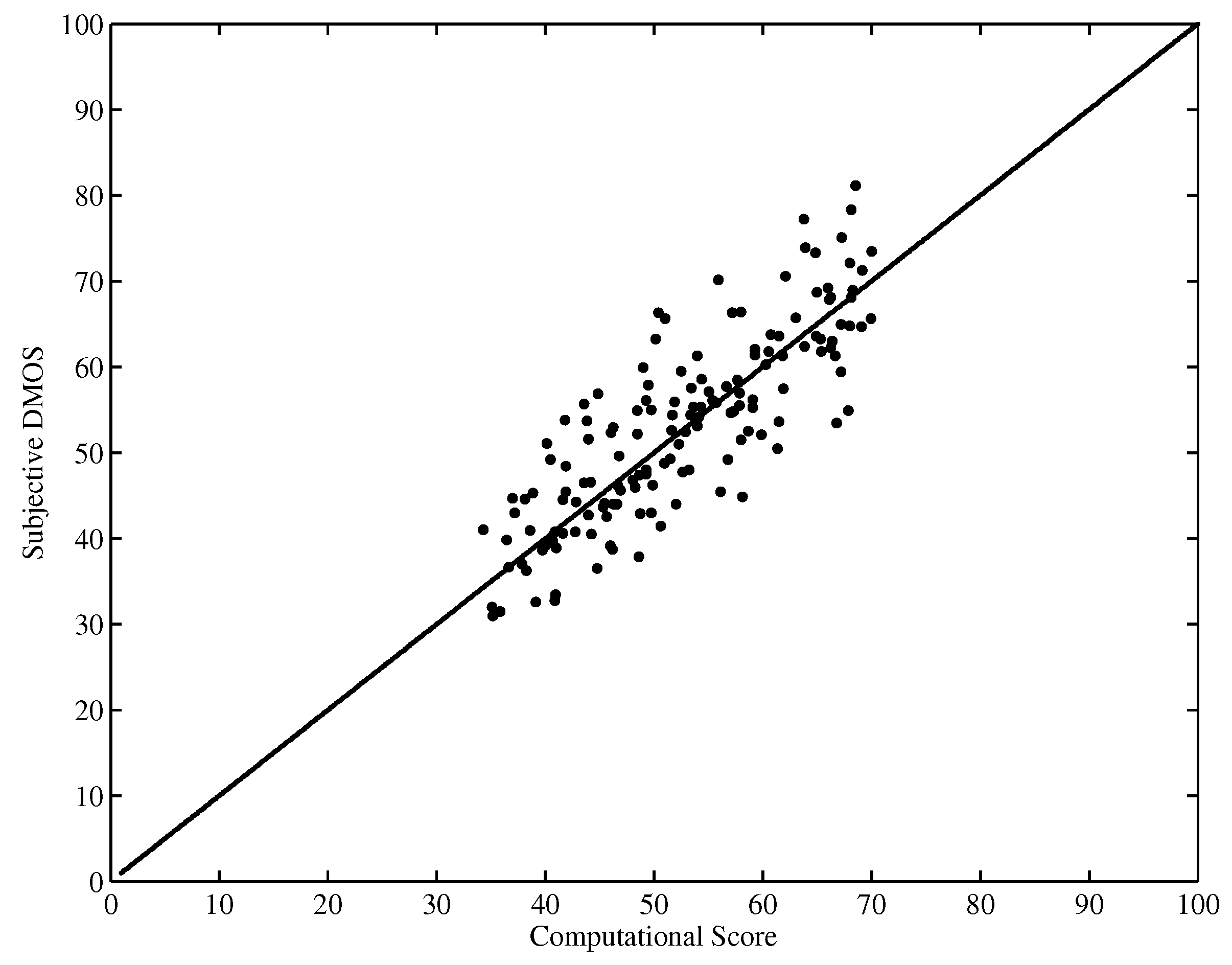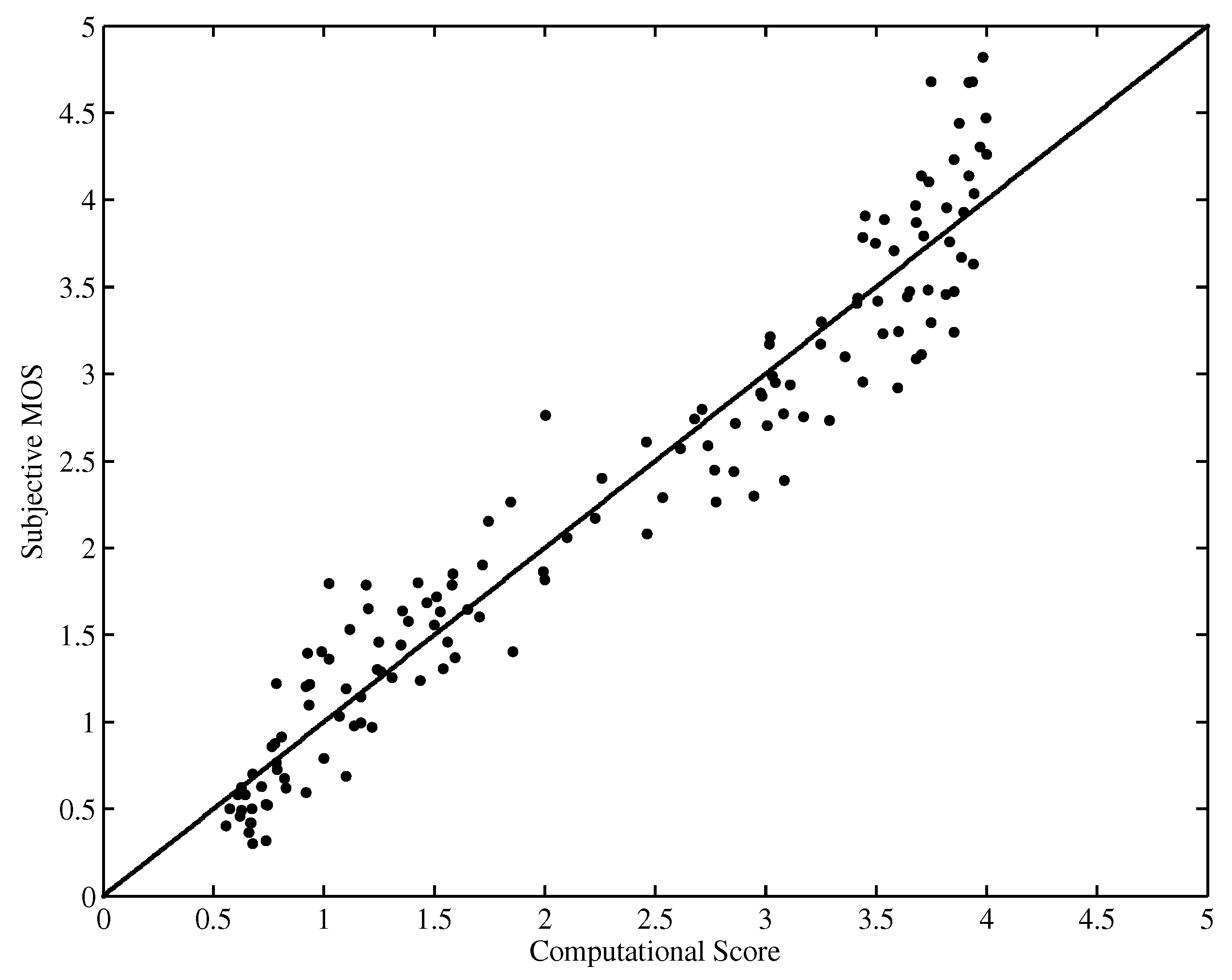1. Introduction
Recently, video quality assessment (VQA) metrics which can evaluate the video quality consistent with the human perception have received increased attention. VQA metrics are generally classified into three categories, full-reference (FR), reduced-reference (RR), and no-reference (NR) metrics. A full-reference (FR) metric aims to evaluate the qualities of distorted videos with the full available reference videos. Peak signal-to-noise ratio (PSNR) and Mean square error (MSE) [
1,
2] are the most widely used FR metrics. These indices are simple to calculate and can be conveniently adopted in video and image applications, such as image processing and video coding [
3,
4,
5]. However, they show poor consistency with subjective evaluations [
6].
Many efforts have been made to investigate the FR VQA algorithms. Structural similarity index (SSIM) [
7] is the most popular metric. The comparison functions of luminance, contrast, and structure are designed and combined to obtain the overall quality. SSIM-based VQA metrics have been proposed by introducing motion information, temporal weighting schemes, and multi-scales-based schemes [
8,
9,
10]. These metrics are developed based on the assumption that the degradation of perceptual qualities is highly related to the change of the structural information. Moreover, gradient-based metrics have been proposed to describe the loss of the structural information [
11,
12]. In [
12], edge-strength similarities were calculated for all pixels to acquire the overall quality score for each frame. In [
13], the gradient-based 3-D structure tensors were decomposed to evaluate the video perceptual quality. Spatio-temporal gradient features were extracted to derive the 3-D structure tensor, and the corresponding eigenvalues and eigenvectors were used to evaluate the video perceptual quality.
In this letter, a VQA metric is designed based on a hierarchical gradient similarity model. This model is inspired by functional principles of the processing hierarchies in the primate visual system [
14], which is characterized by a sequence of visual areas. These areas are modeled by hierarchical gradient measures to evaluate the score of each frame. The evaluation of visual attention similarity by an efficient measure is also involved in the proposed metric. Then, an averaging operation is performed to obtain the final score of the video sequence. Experimental results show that the proposed VQA metric outperforms the state-of-the-art VQA metrics.
2. Hierarchical Video Quality Assessment
As shown in
Figure 1, the neuronal processing of visual information starts from the retina. Before the visual information reaches the visual cortex, it projects to a visual area named lateral geniculate nucleus (LGN). This stage is called
precortical processing [
14]. The occipital part of the primary visual cortex covers area V1–V4 and middle temporal (MT) area [
15]. In the early visual areas, simple image features are extracted over small local regions. Then, this information is transmitted to the higher visual areas, in which more complex features are extracted covering larger and larger regions. The occipital part gives input to the
ventral pathway (VP) and
dorsal pathway (DP) [
15]. The stream (V1→ V2→ V4) to the ventral pathway is critical for object discrimination, and the stream (V1→ V2→ MT) to the dorsal pathway is functionally related to visual motion [
14]. This strongly indicates that these areas compute generic scene representations of visual information [
16].
In this study, in order to assess the video quality in a manner consistent with human perception, the assessment of visual information is inspired by the hierarchical processing in the primate visual system. LGN is modeled as band-pass filtering, and the areas are modeled with hierarchical gradient measures. Furthermore, visual attention similarity evaluated by a new efficient measure is involved successively. As shown in
Figure 2, the reference video and the distorted video are denoised respectively. Each video is divided into two parts: a prediction part (denoted as
and
respectively) and a noise part (denoted as
and
respectively). MSE between the noise parts is evaluated, and the hierarchical gradient measures are performed on the prediction parts. The hierarchical gradient measures consist of pixel level (PL) gradient similarity, block level (BL) gradient similarity and frame level (FL) gradient similarity. It should be noted that the proposed metric reacts in the same way to different types of distortion.
2.1. Modeling of the Precortical Processing
The precortical processing stage in the area LGN has a band-pass filtering characteristic for luminance stimuli [
14]. This can be modeled by a denoising operation. A recent study [
11] showed that perceptual distortion can be classified into content-dependent distortion and content-independent distortion. Content-independent distortion is mainly related to the additive noise. Thus, using the denoising operation, both the reference and distorted frames are decoupled into two parts: the
prediction part and the
noise part. In this paper, block-matching and 3D filtering algorithm (VBM3D) [
17] is employed for denoising. Furthermore, since MSE presents a good match with the additive noise [
18], the MSE is adopted to evaluate the degradation of the noise part:
where
and
are the noise part of the reference and test videos, respectively;
denotes the MSE between
and
. The denominator
is used to normalize the metric into the range [0,1]. In the numerator, adding 1 is to avoid to be smaller than 0. A
approximately equal to 1 means the distortion is more weak.
2.2. Modeling the Stream to the Dorsal Pathway
Areas V1 and V2 contain cells that respond preferentially to linearly-oriented patterns, such as edges, bars, and gratings [
14]. Edge detection such as Sobel filter can be used to model the processing of these areas. Furthermore, the MT area is dedicated to visual motion such as motion gradients, motion-defined edges, and locally opposite motions. Thus, the stream to the dorsal pathway can be modeled as a spatio-temporal gradient.
Since the spatio-temporal gradient vector also contains the components of the spatial version, the similarity of the spatio-temporal gradient vector is used to model the stream to the dorsal pathway. To balance the effect of the temporal and spatial gradients, each component is divided by the sum of positive filter coefficients, respectively. The similarity is evaluated as
where
denotes the gradient similarity between
and
, which are the pixels in prediction parts of the reference frame and the distorted frame, respectively. The vectors
and
denote the corresponding spatio-temporal gradient vectors, which are calculated by the Sobel filter along
x,
y, and
t directions, respectively; i.e.,
. The Sobel kernel for the
t direction is a
matrix [
13]. The parameter
is a small constant to avoid the denominator being zero, and is set as
. The first term represents the similarity of the strengths between
and
. The second term represents the similarity of the directions between the two gradient vectors. Equation (
2) can be further simplified to:
Using (
3), each pixel will get the DP similarity.
2.3. Modeling the Stream to the Ventral Pathway
Both of the streams to the ventral and dorsal pathways contain the areas V1 and V2. Therefore, in order to reduce repetitive computation, only area V4 should be modeled. Area V4 is important for the perception of shape/curvature discrimination. The features are extracted over larger regions instead of local regions. In this study, it is modeled by the block-level gradient vectors similarities. The reference and distorted video frames are split into
non-overlapped blocks. The mean values of the blocks construct down-sampled versions of the images. The spatial gradient of the down-sampled images are used to evaluate the similarity,
where
denotes the block-level gradient similarity between the blocks
and
, which are the blocks in the prediction parts of the reference frame and the distorted frame, respectively. The formula is similar to Equation (
3), whereas the difference is the vectors
and
are the 2-D spatial gradient vectors of the down-sampled images. Using (
4), each block will get VP similarity.
2.4. Visual Attention Similarity
Representations in the visual cortex are known to be overcomplete. Visual attention models [
19,
20] show that the human visual system is more sensitive to salient regions. The similarities of only the salient pixels are selected to evaluate the perceptual quality. Similar to [
13], pixels are determined to be the salient pixels if their spatio-temporal gradient magnitudes are above a threshold in either the reference video or the distorted video. The threshold is defined to be the average of the
kth largest gradient magnitudes in the prediction parts of the reference frame and the distorted frame, respectively. It should be noted that the salient pixel detection is different from the traditional salient region and salient object detection methods. The proposed method is designed specially for video quality assessment so as to put more emphasis on important pixels, in which the salient pixels are distributed dispersedly. However, the salient pixels are concentrated in regions in the ground truth of the traditional saliency detection.
We denote the set of the salient pixels in
and
as
and
, respectively. The union of
and
—denoted as
—is the set of the salient pixels selected to be processed. Furthermore, the averaging on the similarities of the salient pixels can be used to evaluate overall similarity. However, it may lose the changes of the visual attention, and cannot represent the degradation of the whole frame efficiently. Therefore, the similarity of the visual attention is introduced as
where
denotes the attention similarity between the prediction parts
and
which are decoupled from the reference frame and the distorted frame, respectively. The numerator
denotes the number of salient pixels in the reference frame. The denominator
denotes the number of the salient pixels in the union set. The difference between the denominator and the numerator represents the newly increased salient pixels. Thus, the ratio between the denominator and the numerator represents the VA similarity. Since the salient pixels are detected as the pixels with high gradient magnitudes, the VA similarity is considered as the frame-level gradient similarity, as well as the visual attention similarity.
2.5. Overall Score
In the above subsections, degradations in different visual areas are modeled with the corresponding similarities. The final quality index of each frame can be calculated by combining these similarities. For the prediction similarity, the pixel-level similarity, the block level-similarity, and the visual attention similarity are multiplied to evaluate the prediction similarity as
where
denotes the quality score of the prediction part which is decoupled from the distorted frame
. The parameter
denotes the salient pixel in the union set (i.e., only the salient pixels are considered in assessing video quality). The terms
and
denote the pixel-level similarity and the block-level similarity of the pixel
x, respectively. The term
denotes the visual attention similarity.
As in [
11], the noise similarity is used as the exponent of the prediction similarity; i.e., the overall quality score of the frame is calculated as
where
and
denote the quality score of the prediction part and the noise part, respectively. Finally, all of the frame scores are averaged to give the final video quality index.
3. Experimental Results
The effectiveness of the proposed VQA metrics is evaluated by the consistency between the objective scores and the subjective scores, including Mean Opinion Score (MOS) and Difference Mean Opinion Score (DMOS). The consistency is measured by the Pearson correlation coefficient (PCC) and the Spearman rank order correlation coefficient (SROCC). The LIVE [
21] and the EPFL-PoliMI [
22,
23] video quality assessment databases were used to evaluate the performance of the proposed VQA metric. There are 10 reference videos and 150 distorted videos in the LIVE database. All the video sequences are with the size of
. There are four types of distortion: MPEG-2 compression, H.264 compression, and simulated transmission through error-prone IP networks and wireless networks. There are 12 reference videos and 144 distorted videos in the EPFL-PoliMI database. The video sequences have the resolutions of CIF and 4CIF. The videos are encoded using H.264/AVC. The bit streams are corrupted by dropping packets with loss values of 0.1%, 0.4%, 1%, 3%, 5%, and 10% [
22]. Results with the state-of-the-art VQA metrics, including PSNR, SW-SSIM [
8], MC-SSIM [
9], STSI [
13], VQM [
24], MOVIE [
25], ST-MAD [
26], STAQ [
27], and VRF [
28] are compared. Since the reference methods are platform-independent, we copied the values from the reference articles. The results of PSNR and Picture Quality Analyzer are quoted from [
13].
The mapping function adopted for regression of the computational quality score is a four-parameter mapping function, which is also used in STSI [
13]
where
are the fitting parameters.
Table 1 shows the PCC and SROCC of metrics performed on the LIVE database. It is observed that the proposed hierarchical VQA (HVQA) metric significantly outperforms all of the other metrics according to both indicators. The gradient similarity-based VQA metrics (HVQA and STSI) perform better than SSIM-based metrics such as SW-SSIM and MC-SSIM. This indicates that the change of the edge gradient is highly related to the degradation of the perceptual visual quality. This is reasonable for the areas V1 and V2 which are sensitive to the edge patterns. However, the proposed HVQA metric performs significantly better than STSI and ST-MAD. The reason is that degradations over the large regions (e.g., the packet-loss on the flat regions) cannot be represented efficiently by only the pixel-level gradient similarities. The similarities of area V4 and visual attention can improve the efficiency of the metrics. Furthermore, the proposed metric is compared with the optical flow-based VQA metric, MOVIE. HVQA significantly outperforms the MOVIE index (SROCC increment: 0.046), which performs the best in all of the comparison metrics.
To evaluate the effectiveness of the gradient similarities at each visual area, different combinations are reported in
Table 1. The combinations can be classified into three categories. The category I methods use only one of the three measures, including DP, VP, VA. The category II methods use two of the three measures, including DP&VP, VP&VA, DP&VA. The category III method uses all three measures—that is, HVQA. It is observed that the average SROCC and PCC of the category I methods are 0.757. Thus, the similarities of single measure are efficient to represent the degradation of perceptual visual quality. The category II methods significantly outperform the category I methods. This indicates that the combination of two measures will improve the performance. The measures in different visual areas are not with the complete duplicate functions in visual evaluations. Furthermore, the category III method HVQA outperforms any other combinations. That is, the proposed metric is the most efficient for perceptual video quality evaluation.
Table 2 shows the PCC of state-of-the-art metrics performed on four kinds of distortion in the LIVE database, and
Figure 3 shows the performance comparison between these metrics as bar charts. For three of the four distortion types, the proposed metric performs in the top three. For the IP distortion types, HVQA performs the best in the comparison metrics. For the wireless and MPEG2 distortion, HVQA performs the third best and is competitive with the best. For the MPEG2 distortion, the proposed HVQA metric is also competitive with the top three metrics. However, some of the comparison metrics show high performance on only one type of distortion. For example, VQM on MPEG2 type, STSI on IP type, and MOVIE on wireless type; each of them has a high performance on the correspondence distortion type, but do not perform well on the other types. Thus, the HVQA metric is rather robust to various types of video distortion. It is observed that the HVQA metric significantly outperforms the STSI index for all four types of distortion. This coincides with the former analysis showing that the similarities of the area V4 and visual attention can improve the performance. It should be noted that the proposed metric outperforms all of the compared metrics for all distortion types.
In saliency calculation, pixels with the high spatio-temporal gradient magnitudes are determined to be saliency pixels. The threshold is defined to be the average of the largest
k gradient magnitudes. When
k is set to 1, all the pixels are the saliency pixels (i.e., the visual attention is not included in the proposed metrics). As shown in
Table 1, the metric evaluating visual attention significantly (denoted as Proposed (HVQA)) outperformed the metric without evaluating visual attention (denoted as Proposed (DP&VP)). It should be noted that the parameter
k is set to
through exhaustive experiments, which were performed on the LIVE database.
Figure 4 shows the correlation coefficients of the proposed metrics when the parameter
k is set to be different values. The values range from 0.2 to 0.5 with an interval of 0.05. It can be observed that when
k is set to
, both the SROCC and PCC are the largest. For
k set from 0.2 to 0.4, the correlation coefficients are higher than 0.8. However, when
k is larger than 0.4, the correlation coefficients become small (i.e., evaluating visual attention can improve the performance of the proposed metric). The robustness is also validated by evaluating the proposed metric on the EPFL-PoliMI database in the following paragraph.
In order to further investigate the robustness of the proposed metric, it is also evaluated on the EPFL-PoliMI database.
Table 3 shows the results of the proposed HVQA metrics as well as the comparison metrics (the reference values are copied from [
29]). It can be observed that the PCC and SROCC of the HVQA metric are both higher than 0.965, which indicates high consistence with human perception. Furthermore, the proposed HVQA metric significantly outperforms the comparison results, including the MOVIE and MS-SSIM. Therefore, the proposed hierarchical gradient-based metric is robust and efficient.
Figure 5 and
Figure 6 show the scatter plot of the DMOS (MOS) against the objective computational score performed on the LIVE database and EPFL-PoliMI database, respectively. It is observed that the proposed HVQA metric performs well on videos ranging from low quality to high quality for both databases.
